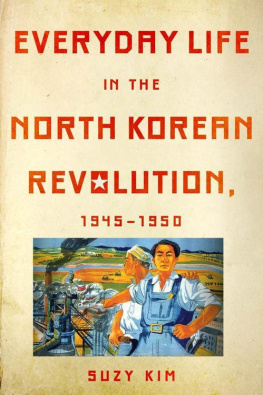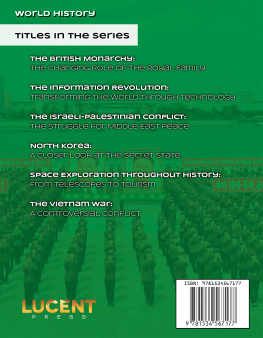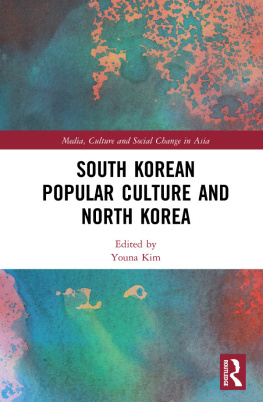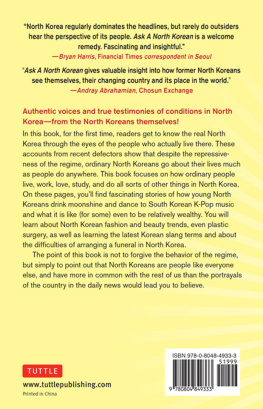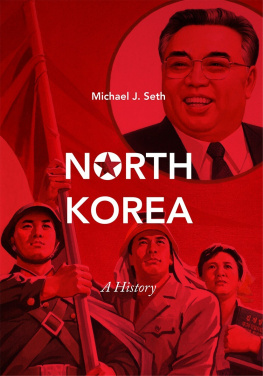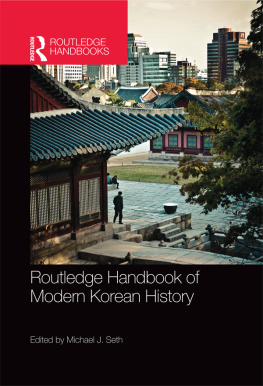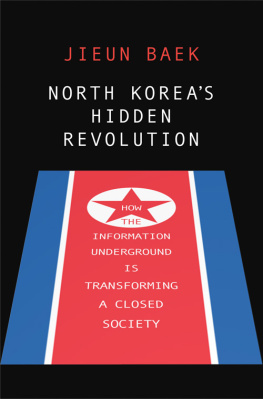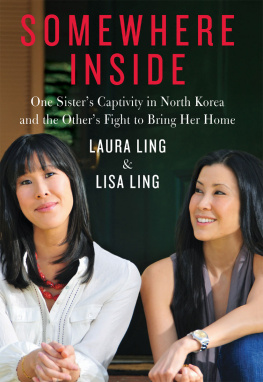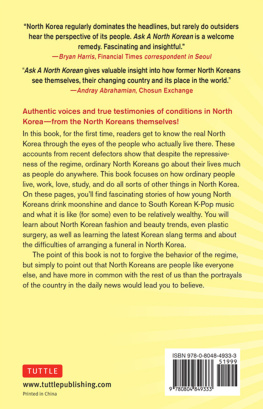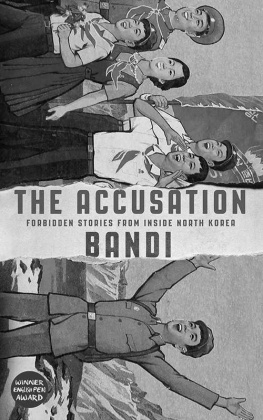Everyday Life in the
North Korean Revolution,
19451950
Suzy Kim
Cornell University Press
Ithaca and London
Contents
Illustrations
Tables
4.1. Class background of party officials at various levels over time in Inje County
Acknowledgments
Academic and intellectual work can be an intensely solitary endeavor, but this book is the result of a genuinely collaborative journey that began at the University of Chicago. My greatest thanks go to Bruce Cumings, whose scholarship has been an inspiration for its rigorous pursuit of truth and justice while he remains a compassionate historian above all. He has been there from the very inception of the project to the last draft of the manuscript. I am also grateful to Kyeong-Hee Choi, who injected the renewed significance of womens studies into my academic training, opening up a whole new world of inquiry. William Sewell and Friedrich Katz were valuable guides in comparative studies of revolutions and communisms, respectively.
A close community of cohorts continued to provide encouragement and support throughout the past ten years. Henry Em, Albert Park, Saul Thomas, and Yoon Sun Yang have unstintingly shared their time amid their own busy schedules to read the manuscript in whole or in part and to comment on and critique it at various stages. I thank them for their genuine friendship. Chong-myong Im, Namhee Lee, Mike Shin, and Jun Yoo have also provided support in many ways, from offering opportunities to present my work to furnishing countless research and teaching materials.
My home department of Asian Languages and Cultures at Rutgers University gave me much needed time to finish the book, and I am particularly grateful for my senior colleague, Young-mee Yu Cho, for her generosity. A fellowship at Seoul National Universitys Kyujanggak Institute for Korean Studies accommodated my sabbatical leave in the last year of finalizing the book, and I thank Professors Pak Tae-kyun and Sem Vermeersch for their hospitality. I also thank Professor Chng Yong-uk, his modern Korean history graduate students, and the Korean History Department for hosting a colloquium where I benefited from comments about my work. In addition, Professors Kim Myng-hwan and Chng Kn-sik were vital mentors on an otherwise unfamiliar campus. Likewise, opportunities to present my work at Yonsei University, hosted by Professors Paek Mun-im and Sin Hyng-ki, and at Chonnam University, hosted by Professor Im Chong-myng, were much appreciated. At a much earlier stage, Professors Pang Ki-jung and Kim Sng-bo at Yonsei University were generous guides during my research, and I learned a great deal in their seminars.
Various stages of research and writing have been supported by funds from the Korea Foundation Postdoctoral Fellowship at the University of Michigan, the University of Chicago Center for East Asian Studies Dissertation Writing Fellowship, the University of Chicago Gender Studies Fellowship, Foreign Language and Area Studies Fellowship (Title VI) from the U.S. Department of Education, Fulbright IIE Dissertation Research Fellowship, and a graduate studies fellowship and a travel grant from the Northeast Asia Council of the Association for Asian Studies.
An earlier version of chapter 6 was published in Comparative Studies in Society and History (October 2010) and I acknowledge Cambridge University Press for permission to publish an expanded version here. Roger Haydon at Cornell University Press has been a steadfast steward throughout the arduous process of getting the manuscript to press, and I am grateful for his guidance and the helpful comments offered in the anonymous reviews he commissioned. I had the great fortune to have John Raymond as my copyeditor, who went beyond the call of duty to lend a sympathetic and careful reading of the manuscript, not only to improve its readability but also to make it more coherent. In that regard, I must also thank Susan Specter for putting the manuscript in Johns care and for meticulously going through the edits one last time.
The whole winding journey would not have started or continued without two communities outside academe. First, my family deserves much of the credit for the tenacity the project required, especially my mother, Jaehi Kim, and my partner, Isaac Trapkus. Their perseverance and patience will always put me to shame. More than anyone, I owe my mother for teaching me true grit. And second, I learned much from the families and staff at Minkahyup, a human rights group based in Seoul, who opened my eyes to the social and political world. Sadly, one of them passed away as I finished the book. It has been almost twenty years since I worked there, but the experience has stayed with me, reminding me what it means to live in this world and not just study it.
Note on Usage
I have used the McCune-Reischauer system for the romanization of Korean names and terms, except in quoting original North Korean publications in English and in cases where the spelling has become common usage, such as in Pyongyang or Kim Il Sung. I have kept the last name first in referring to Korean historical figures in the text and to Korean authors in the notes, as is the standard practice in Korean unless they have their own romanized names. For the romanization of foreign terms other than Korean, I have simply duplicated the system used in the source consulted. In the discussion of the colonial period in chapter 2, I have indicated Japanese terms with a J where it was unclear whether the transliterated term was Korean or Japanese.
The two Koreas were officially named the Democratic Peoples Republic of Korea (DPRK) in the north and the Republic of Korea (ROK) in the south with the founding of separate states in 1948, but following general convention I refer to them in shorthand as North Korea and South Korea. For consistency, I also use these terms with the beginning of the two separate occupation zones in 1945 despite the fact that they were not two separate states until 1948.
All translations are mine unless otherwise indicated.
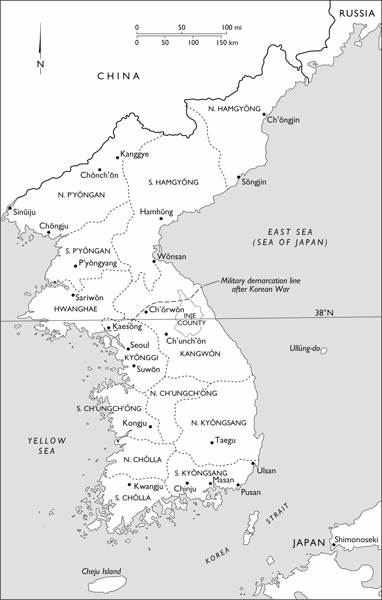
Introduction
A satellite image of the Korean Peninsula at night shows South Korea and the surrounding regions bathed in light while North Korea seems engulfed in darkness except for the capital city of Pyongyang. The image has symbolized North Koreas backwardness since U.S. Secretary of Defense Donald Rumsfeld referred to it during a news briefing on December 23, 2002: If you look at a picture from the sky of the Korean Peninsula at night, South Korea is filled with lights and energy and vitality and a booming economy; North Korea is dark. From this description, he concludes matter-of-factly, It is a tragedy whats being done in that country. To be sure, North Korea has serious problems, but what is the precise nature of the tragedy?
A closer look at the process of creating the image reveals a more complicated picture. A product of modern technology, it is a composite of multiple images from repeated orbits around the earth236 to be exactwith sophisticated algorithms to adjust for anomalies such as fires and lightning. In other words, it is not an image that the naked eye could see from the sky, nor an image that speaks for itself, as Rumsfeld would have us believe. It is a constructed image, made possible only through sophisticated engineering. It is worth pondering to what extent other images of North Korea are deployed to fit certain premises.
Rumsfelds conclusion linking light and energy with a booming economy implies that economic growth is an inherent good, and without it there is only tragedy. However, as unrestrained consumption of energy comes under growing scrutiny, it is no longer clear how desirable it is for so much light to flood such uneven patches of the globe. North Korea is not the only place in the world without as much light as South Korea or Japan. Vast inhabited stretches of Africa, South and Southeast Asia, and China do not come close to the amount of electricity consumed per capita Rather than split the world into simplistic binaries of light and dark as markers of good and evil, in this book I start from the premise that the world is integrated, particularly with the acceleration of modernity that, beginning in the nineteenth century, compressed time and space, creating a world that is highly uneven, with some places modernizing at the expense of others.
Next page
